Teacup Pomeranian – Breed Profile & Information
June 24, 2021 2024-06-20 1:53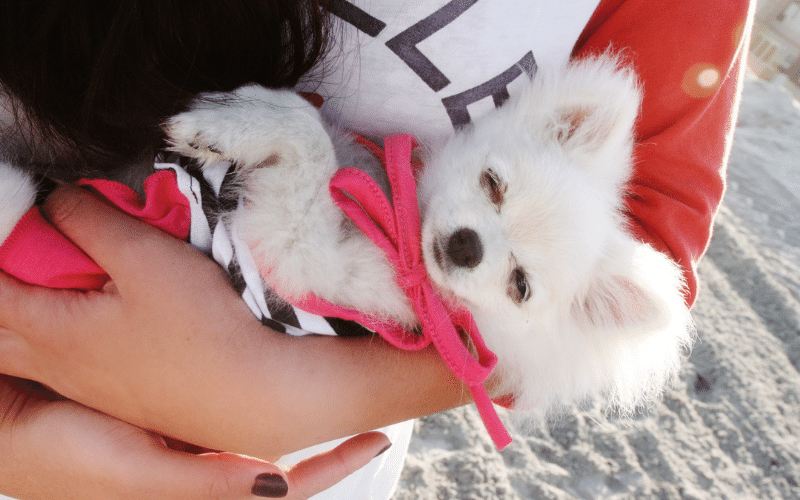
Breed Overview
Breed Type
Toy Breed
Care Level
Intermediate
Size
Very small
Trainability
Highly trainable
Sociability & Friendliness
Intelligence
Strength
Family Dog
Physical Exercise Needs
Mental Exercise Needs
Guard Dog/Protection Instincts
Suitability For Dog Sports
Health & Longevity
Grooming Needs
Shedding
Apartment Dog
Suitable For First-Time Owners
Table of Contents
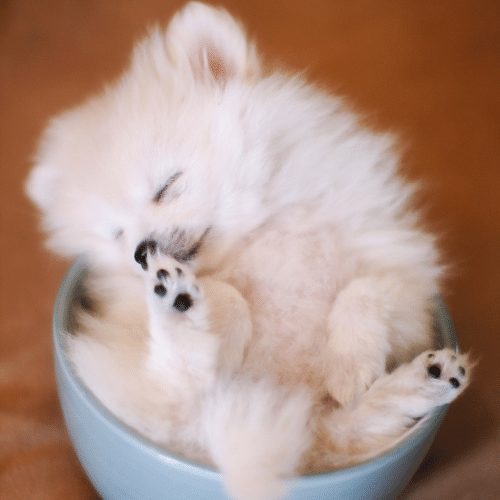
Origin & history of the Pomeranian
The Teacup Pomeranian is not actually a recognized breed. This is because so-called Teacup Poms are just like regular toy-sized Pomeranians, only they have been bred to be smaller, but they are genetically the same. However, unlike most Teacup dogs, the breeding of ever-smaller Pomeranians is not a modern phenomenon.
Pomeranians are a remote relative of Huskies and descended from the much larger, ancient German Spitz breeds that pulled sleds in the arctic. They are thought to have also worked as sled dogs and guard dogs for homes and farms. Pomeranians acquired their name from Pomerania, an area that borders northern Poland, Germany, and the Baltic sea, where their lineage likely hails from. Their exact history is undocumented and unknown until they were bought to Great Britain in the 1700s.
They really began to gain notoriety when Queen Charlotte, consort of King George III, took on two Pomeranians in 1767, introducing the breed to England. Back then, however, they were much larger dogs than they are today. When King George and Queen Charlotte’s granddaughter and fellow dog enthusiast Queen Victoria was queen, one of her favorite dogs was a Pomeranian called Marco, who was naturally very small.
As a result, smaller Pomeranians became incredibly fashionable, and breeders began to breed the dogs to be smaller to meet the demand. In fact, during Queen Victoria’s lifetime, the size of the average Pomeranian dog decreased by half and they are now the smallest of any Spitz breed. They’re even known as “Zwergspitz” – or “dwarf Spitz” – in many European countries.
The modern Pomeranian
The first Pomeranian kennel club was set up in Great Britain in 1891, and the first breed standard was written shortly afterward. They made their way over to the United States in 1898 and were recognized by the American Kennel Club in 1900.
They remain a very popular breed in both the US and the UK, as well as in their area of origin in Europe. Poms also commonly compete in dog shows because of their beautiful appearance. Their closest relatives are those that are also descended from Spitz breeds; such as the Norwegian Elkhound and the American Eskimo Dog. Crossed with Teacup Chihuahuas they create the Pomchi, another highly sought-after lap dog breed.

The Teacup Pomeranian
In recent years, tiny dogs have seen another boom in popularity due to their status as the perfect “purse dogs”. As a result, small and toy breeds such as the Pomeranian are being bred to be even smaller, prompting the variation commonly known as Teacup Pomeranians. Whilst they are not a recognized breed in their own right; they do harbor a significant difference in size to regular Pomeranians.
Teacup dogs were originally, and still can be, the result of two naturally very small dogs being bred together. However, the fashionability of tiny Teacup dogs has lead to breeders resorting to unethical tactics in order to create the smallest dogs possible. This includes breeding runts, inbreeding, and malnourishment.
Runts of the litter are often smaller because they have birth defects, however, this also means that their offspring are likely to be unhealthy too. Similarly, inbreeding increases the risk of malformations and passing on genetic conditions, and malnourishment stunts the development of a dog’s skeleton and internal organs.
This is why many dog lovers are against buying Teacup dogs, as to not contribute to the fad and encourage bad breeding. Budding buyers should also beware that there are scam breeders out there that sell fake Teacup puppies at extortionate prices, when they are in fact, regular pups that will grow up to be normal-sized.
If you’re desperate for a Teacup dog, do thorough research and find a highly-rated breeder with a good reputation or adopt from a rescue shelter. Never buy dogs from anonymous online adverts to avoid scammers and always ask breeders for health documents. Additionally, try to visit the pup you’re interested in before making any purchases.
Breeding & puppyhood
Teacup Pomeranians tend to be born into litters of 2-4 puppies and they typically weigh less than a pound at birth. They tend to reach their full, adult size at around 12 months old. Pregnancy can be difficult for Teacup mothers because of the pressure it puts on their tiny bodies.
For the same reason, dystocia or difficult birth is common in these dogs, and many Teacup mothers end up undergoing cesarean sections. So, Teacup Pom breeders should familiarise themselves with the signs of dystocia in dogs and always have their vet’s phone number on hand just in case.
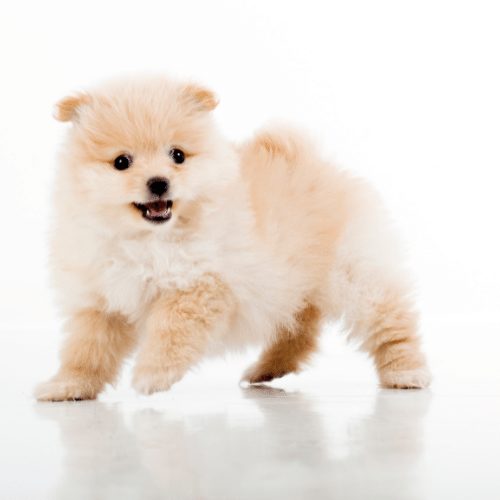
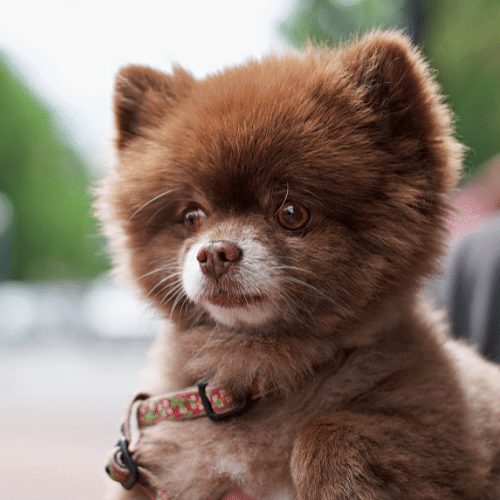
Appearance
The average Teacup Pom stands at around 6-10 inches tall and weighs between 5-7 lbs depending on the gender of the dog. They are compactly built, sturdy dogs with fox-like faces and ears. They have very distinct, identifiable fluffy coats, with large roughs around the neck and feathery, plumed tails.
Pom coats are double-layered and thick with straight, feathery fur. They come in a beautiful array of colors and combinations including black, white, cream, brown, orange, red, blue, beaver, blue merle, chocolate merle, black and white, black and brown, brown and white, brown and tan, tri-colored, a number of sable and brindle variations, and even blue and lilac.
A Pom’s coat may change color completely from when they are puppies to when they are fully grown, and common markings in Poms with more than one color in their coat include facial blazes, defined eyebrows, stripes or patches on the chest, back, and stomach, and different colored feet and tail tips.
Personality
Teacup Pomeranians are active, playful, extroverted, and intelligent dogs. They’re very loyal and protective of their owners and families, getting on especially well with children. Although they are friendly, they can be a little standoffish with strangers at first until they get to know them.
Although Poms are wilful and independently minded, they are also very social and require lots of love and companionship. This combined with their high intelligence means they commonly suffer from boredom and separation anxiety when their needs are not met.
Poms also have a tendency to be possessive, territorial, vocal, and cautious of other dogs because of their size and history as guard dogs. To prevent these behaviors, training and socialization should start as early on in your Pom’s life as possible.
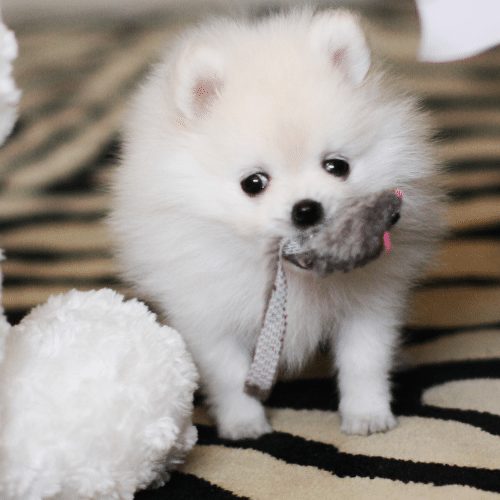

Training a Teacup Pom
Teacup Pomeranians are highly trainable and keen to learn, but they also have an extremely stubborn streak. To avoid obstinate behavior, owners should focus on building a bond first and training sessions should be kept short and positive.
The use of a behavioral marker such as a clicker will speed up the training process. Negative signals such as the word “no” need to be used consistently and associated with something bad, (such as being ignored), to eventually be effective on their own.
Areas that Pom owners may have to particularly focus on include separation anxiety, territorial and possessive behaviors, and socialization to avoid aggression.
Separation anxiety is when your dog feels intense anxiety when the two of you are apart. It can result in excessive barking and destructive behaviors towards themselves and the home. It can be tackled by providing sufficient exercise and mental stimulation, leaving minimal room for stress. It’s also good to encourage solo play with the use of puzzle toys and treat dispensers to show them that time alone can be fun.
You should start practicing their alone time by leaving the house for small periods of time, and gradually build up the time that you spend apart. This way they understand that you will always come back and it slowly boosts their independence. It’s best to leave them with a treat or toy to make a positive association with being alone. Never make a big deal about leaving, but always make a big fuss of them when you come back so that they know they have something to look forward to when you go out. You could even invest in some anti-anxiety products to aid your training, such as herbal supplements and plug-in diffusers.
If your dog is destructive when they are alone at first, you could try putting them in a crate or using a dog gate to keep them restricted to a certain area until the behavior calms down. Although it is frustrating, do not react angrily to destructive behavior, as they will probably enjoy the attention and it will make them more likely to do it again. Instead, show them that this kind of behavior gets no attention.
Territorial behaviors such as excessive barking whenever someone walks past your home can be tackled by practicing recall, rewarding good behavior, and reducing the anxiety of strangers with socialization.
Possessive behaviors such as aggressively guarding food and toys can be tackled by building trust through quality time and teaching “leave” and “drop” commands. Staying quietly close by when they eat and play also builds trust over time as they learn that you’re not interested in their things. When you do have to take something away from them, always replace it with something else to show them that you aren’t just going to take things away.
Socialization can be done at home and on walks. Try inviting trusted family members and dogs over to your home and interacting with friendly dogs on walks.
Are Teacup Poms good family dogs?
Teacup Pomeranians love family life and make good family dogs. They enjoy being involved in all aspects of family life and are gentle with children. That said, they are also snappy during puppyhood and are easily injured because of their size, so they’re not well-suited to families with very young children.
Owners with children looking to get a dog should teach their kids how to interact with dogs. They should be taught to let unfamiliar dogs come to them and never approach a dog when they are eating until they have built a strong bond. Even then, some dogs never grow out of resource guarding behaviors. It’s also essential that children are taught to be physically gentle and kind to animals, which means no shouting, teasing, or pulling on whiskers and tails.
With plenty of exposure and socialization, Teacup Poms will get along well with other family pets. But, again, because of their size and fragility, homes with large or particularly clumsy pets may not be the best fit for teacup Poms.
Are Teacup Pomeranians noisy dogs?
Both Teacup and regular-sized Pomeranians are known to be vocal dogs because of their working background. It’s quite literally in their DNA to be noisy. However, growling and barking are not inherently bad behaviors. Barking is just a Pom’s way of expressing how they are feeling, especially when they are having fun.
Owners shouldn’t necessarily tell their Poms off for growling or barking a little bit during play, as it is just their way of communicating that they are having fun. However, if it becomes excessive, you can train your dogs to stop barking by stopping play. This way, dogs learn that the fun stops when they start being noisy.
Excessive barking outside of play can also be a sign of other things, such as boredom and separation anxiety. Barking tied to negative behaviors like aggression should have the underlying issues addressed.

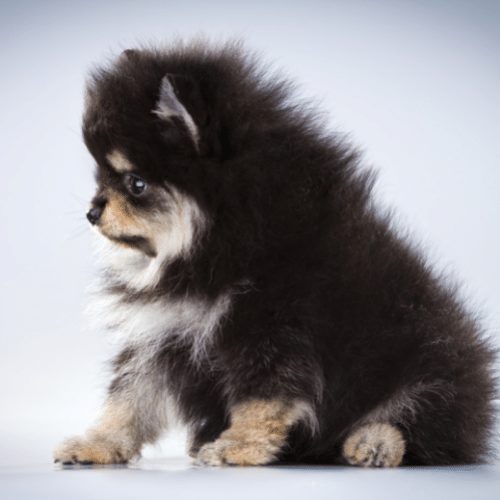
Are Teacup Pomeranians healthy?
Both regular Poms and Teacup Poms have an average lifespan of 12-15 years. They are generally healthy dogs, but all breeds are naturally more susceptible to certain conditions. Teacup dogs also come with their own separate health risks because of their size.
Teacup Pomeranians that have been bred using bad practices run the risk of malformations, but Teacup dogs, in general, are also significantly more likely to get injured, break bones, and not survive accidents. Even accidents at home that we would consider minor for other dogs, such as falling off of furniture, can be dangerous for these tiny dogs and their fragile bodies.
Because of their size, Teacup dogs are also at a very high risk of developing hypoglycemia. This is when the blood sugar lowers to a life-threatening level. It can happen very quickly in such small dogs, after missing as little as one meal. Symptoms include lethargy, low mood, loss of appetite, impaired vision, tremors, fainting, and seizures.
Common health problems in Pomeranians
Common health conditions among the Pomeranian breed include luxating patella, tracheal collapse, alopecia X, hypothyroidism, and heart failure, the most common cause of death in older Poms.
Luxating Patella
A luxating patella, or trick knee, is a condition that causes the patella, or kneecap, to dislocate. It’s fairly common among small dogs and can be diagnosed and graded on severity following a simple veterinary examination. Its causes can be genetic or traumatic, but the condition can only be corrected with surgery.
That said, surgery is only necessary if it is causing the dog pain and most dogs with the condition don’t feel any pain or discomfort. A mildly dislocated patella can be managed with lifestyle changes and physiotherapy.
The symptoms of a luxating patella in dogs include:
- Limping or skipping
- Walking on three legs
- Lameness
- Stiffness
- In extreme cases, whining and licking the affected knee
Tracheal Collapse
The trachea or windpipe is a flexible tube with sturdy cartilage that keeps the windpipe open, helping us to breathe. Tracheal collapse is a progressive breathing condition that occurs when the cartilage collapses, resulting in breathing problems. The exact causes are unknown but it most commonly affects middle-aged small dogs.
Vets can diagnose tracheal collapse with a simple examination, and it can be treated medically, surgically, or with a combination of the two. However, most dogs will still go on to experience at least some coughing, but their length and quality of life shouldn’t be affected.
The most helpful thing owners can do is keep their dogs at a healthy weight, use a body harness instead of a neck collar, prevent over-excitement, and avoid exposing your dog to tobacco smoke.
The symptoms of tracheal collapse in dogs include:
- Difficulty breathing and wheezing
- Coughing, especially when pressure is applied to the throat area
- Gagging or vomiting
- Cyanotic (turning blue) episodes
Alopecia X
Alopecia X is a hereditary skin condition that results in patches of hair loss and the skin underneath turning a much darker color. It can start early on in life or later in old age, but it is purely cosmetic and does not affect the health of affected dogs. Treatment is not a necessity but can be done for cosmetic reasons.
Cosmetic treatment includes stimulating the growth of hair follicles with a topical glycolic shampoo and normalizing the maturation of the skin with oral retinoid therapy and melatonin supplements.
The symptoms of alopecia X in dogs include:
- Gradual or spontaneous symmetrical hair loss, typically over the back end and hind legs
- Hyperpigmented skin in the affected areas
Hypothyroidism
Hypothyroidism is a condition in which the thyroid gland doesn’t create enough of the thyroxine hormone. It can cause internal systems such as the digestive system to slow down. In most cases, the causes are unknown.
Diagnosis can be tricky, as there are several conditions that mimic hypothyroidism. Vets may take multiple blood tests before arriving at a diagnosis. Dogs diagnosed with the condition will be prescribed thyroxine and have to take it for the rest of their lives, but it shouldn’t otherwise affect their lives.
The symptoms of hypothyroidism in dogs include:
- Lethargy
- Low mood
- Weight gain & obesity
- Intolerance to cold and exercise
- Increased shedding or hair loss
- Thickening of the skin
Heart failure
Pomeranians are prone to multiple types of heart disease, particularly a kind called patent ductus arteriosus, which can occur both early and later on in life. Causes can be congenital, age-related, lifestyle-related, or a combination of all three.
Early detection can prolong the affected dog’s life for many years with medication. A healthy diet also goes a long way. Vets can diagnose heart problems by listening to a dog’s heartbeat and conducting various scans and tests such as ECGs.
The symptoms of heart disease in dogs include:
- Lethargy and exercise intolerance
- Shortness of breath
- Coughing
- Fainting
- Swollen abdomen
Teacup Pomeranian care
Teacup Poms don’t need huge homes because of their size, but, as with all dogs, somewhere with outside space is preferable. People that work full-time are not the best match with Pom dogs as they don’t do well alone for long periods of time.
Budding Teacup owners should also safety-proof their homes by making sure any hazards or high surfaces are off-limits, blocking off stairs so that they can’t be used unsupervised, putting rugs anywhere falls are likely, and escape-proofing yards.
Because of their size, Teacup Pomeranians only eat around ¼ a cup – ½ a cup of food per day. However, they can experience digestive issues and low blood sugar very easily because of their tiny bodies, so it’s essential that they are fed correctly.
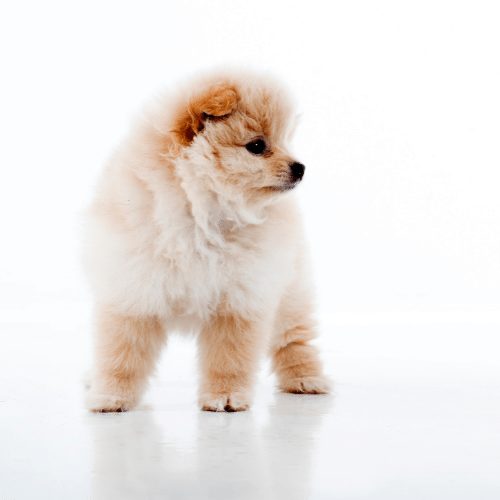
A Teacup Pom should be fed small meals every 4-5 hours and eat nutrient-rich kibble containing Karo syrup to prevent their blood sugar from dropping. Their diet should also consist of high-quality protein, healthy fats, and lots of fiber to avoid digestive issues. The size of their food is important, too, as Teacup dogs are a lot more prone to choking because of their little mouths.
As with all dogs, low-quality commercial dog foods with filler ingredients should be avoided.
Teacup Poms need about half an hour of exercise a day, preferably be split into two walks. They also need plenty of mentally stimulating play to prevent boredom and subsequent destructiveness. It’s wise to set aside time each day for fun games like hide and seek and invest in some mentally challenging toys to wear out your Pom’s mind. Puzzle toys, slow feeders, treat dispensers, and sensory toys are great for mental stimulation.
They also need regular brushing at least three times per week and as regularly as every day in heavy shedding seasons, (summer and winter), to remove loose fur and prevent matting. This will also help to keep them cool in the summer months and stop all of that hair from ending up on your floor. Pomeranians don’t need bathing more than once every couple of months and they don’t usually need haircuts either.
The cost of Teacup Pomeranians
The average cost of a Teacup Pomeranian is currently between $1,000 and $6000 in the US, although it can be even more. They are expensive because they are so fashionable. In fact, they are the third most popular Teacup dog breed in the US behind Chihuahuas and Malteses. The exact price of a Teacup Pom pup will depend on a few different factors.
First of all, the breeder you buy from will massively affect the price tag. Buying a puppy from a large, commercial breeder will be much pricier than buying one from a small-time or hobby breeder. However, a higher cost does not necessarily mean better care, and with the unethical breeding practices that often take place with Teacup dogs, small-time breeders are usually the best option.
The Pom pup’s lineage and coat color can also affect the price. Those bred from show dogs, for example, will have a much higher price tag than those bred from regular companion dogs. In fact, show dog Pom pups have been known to sell for around $10,000.
As mentioned above, Teacup Poms come in a lot of different colors, and certain colors are rarer than others. Lilac Pomeranians, for example, though not a recognized color, are extremely rare, fashionable, and sought after. Breeders have been known to charge extremely high prices for such colors, often upwards of $5000.
Rescue Teacup Poms will cost the rescue shelter’s adoption fee – which could be anywhere from $50-$400. Adoption fees depend on the size of the adoption center and whether they’re generic or breed-specific. The adoption process is fairly simple. It starts with an application form, which if approved, will progress to meeting the dog in person and the shelter carrying out a home inspection before finalizing the adoption.
Although Teacup Poms are expensive to buy, they tend to be less expensive to look after than other dogs because their size means that they go through fewer supplies. The average annual cost of looking after a Teacup Pom is around $1000 per year, although it will be more in the first year if you buy a Pom puppy.
This is broken up into medical expenses including vet bills and pet insurance, food and treats, toys, grooming supplies, and accessories like beds, collars, and bowls. The average lifetime cost of owning a Teacup Pom is around $15,000.
The bottom line
Teacup Pomeranians are adorable dogs with an interesting history of snow, sleds, guarding, and regality that stretches across the globe. Teacup Poms need owners and families that can handle them with extra care, provide patient training, and lots of love.
If you’re interested in owning a Teacup Pom, please buy from a trusted breeder or adopt from a rescue shelter.
Laura is a dog-lover with an animal-related degree and plenty of hands on experience. She is passionate about dog health & welfare and wants to arm owners with all of the essential info they need!

